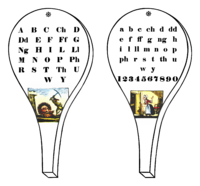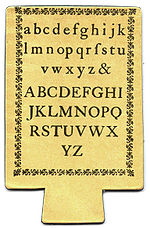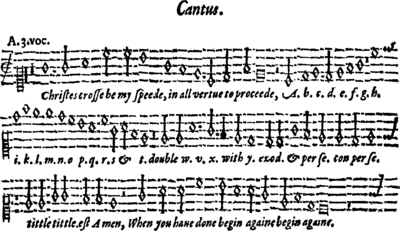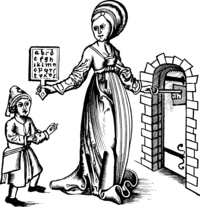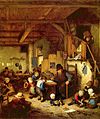Letter board
Letter boards or ABC tablets with an alphabet on them were a learning aid for children that was widespread in various forms from the 15th to the 19th century. With the letter boards, children were given texts for their own use for the first time.
|
Replicas of typical letter tables: on the left an early, in the middle a later English horn book; on the right a cardboard battledore . |
Origin and Distribution
Long before the invention of printing , manuscripts that were used in schools as the first reading book and for devotion were widespread. It is believed that catechisms for children have existed since the 8th or 9th century. ABC tablets made of wood for teaching purposes are mentioned in an English manuscript from the 14th century. Since the late 14th century, manuscripts of an educational nature have been passed that begin with a Christian cross and the alphabet and contain various prayers. An illustrated copy of a work by Sacrobosco dates from around 1400 and shows a plaque with Arabic numerals .
Letter boards may be a further development of the rewritable wax-coated boards used for teaching purposes. It is not known exactly when the first ABC tablet was created. The oldest surviving wooden panels date from the 15th century, but an apparently very old example made of lead has also been reported. There are also letter tables from Roman Britain and Gallo-Roman France. In antique brickworks and housing estates you can find roof tiles that show an alphabet, sometimes longer texts. In the brickworks, these were scraped into the still damp clay before burning, where the workers apparently taught themselves to write and read, at least in rudimentary form. As Einhard wrote in his Vita Karoli Magni (c. 25), Charlemagne tried unsuccessfully to learn to write in insomnia using blackboards and books ( tabulas et codicellos ).
There were probably two variants of the earliest systematically produced letter boards: a handwritten one to learn to write by copying the letters, and a printed one to learn to read. The term abecedarium is to be distinguished from the letter table , which in most definitions includes letter tables as well as first reading books and primers .
Only the alphabet can be seen on the oldest surviving tablets. In later copies, the ABC was followed by a prayer (usually the Our Father ), which took up the lower half of the sheet. In the end, this variant almost completely replaced earlier panels. Usually the alphabet was preceded by a Greek cross .
Most of the letter boards were made of wood and had a handle. Sometimes a hole was drilled in the handle so that the board could be hung from a belt or over the arm with a string. In continental Europe the handle was often on the top or on the side, in English-speaking countries on the bottom.
Texts and illustrations show that a short pointer , bone, pencil or similar was used for a long time to draw the child's attention to the letters during instruction. The chalkboards were probably used by the children not only for studying but also for playing; some adults used them as a punishment.
Both stationers and peddlers sold ABC tablets. In addition to prefabricated letter boards, there were also individual sheets of paper that parents or teachers had glued onto wooden boards at markets.
ABC tablets were widespread in parts of Europe, and later also in America. There are copies of or at least indications on letter boards from France, Italy, Flanders, the Netherlands, Germany, Bohemia, Denmark, Norway and Sweden. Kurdish and Mexican food banks were also reported. In contrast to the English horn books, very few letter tables from continental Europe have actually come down to us.
As paper became cheaper and cheaper to manufacture over time, books replaced the letter boards by the 19th century at the latest.
14 × 9 cm sheet of a German letter board (design by Daniel Hopfer from the 16th century).
Bartolomeo Schedoni (1560-1616): Le premier des devoirs
Further developments
Horn books

In the English-speaking world, a thin, transparent sheet of horny substance held in place by metal strips and nails covered the paper stuck to the board to protect it from wear and tear and dirt. Such letter tables are called horn books , although they are not books in the conventional sense.
The oldest surviving horn book comes from the middle of the 15th century; Horn books, however, probably only found general distribution towards the end of the 16th century. Only one or two specimens have survived from mainland Europe; It is very likely that horn books were never widely used outside of England and America , where the first immigrants brought them from Europe but did not produce them themselves. Some Scottish specimens are also known. Some of the older horn books were made in the Netherlands after William Caxton faced competition from abroad.
The use of horn as a material goes back a long way in human history. Even before the first horn books, horn plates were used to protect lettering on the covers of old manuscripts. It is possible that this technique developed into the idea of the horn book. The best known and one of the oldest English companies that processed horn is the London Worshipful Company of Horners . The horn was soaked in boiling water, whereupon it was easy to shape and press into a thin sheet with a press.
Although larger specimens and various materials are known, most horn books measured about 7 × 13 cm or less and were made of oak wood to which the paper was glued. The horn plate was attached to this with about 3 mm wide and millimeter thick metal strips (mostly made of copper or alloys containing copper ). The nails were made by hand. In earlier horn books, their heads were bevelled on four sides (see illustration on the right), so that they protected the horn book from scratches when it was placed upside down on a surface. The strips of metal were thin enough to drive the nails into the wood without drilling holes; they were also easy to trim with normal scissors. The final price of a horn book in the 17th and early 18th centuries was typically in the range of half a penny to two pence.
Over time, the English term hornbook also encompassed wooden letter boards without a horn plate, and in general other forms of these learning aids such as battledores (see below) and any first text for children. Regionally other names or nicknames such as “Horn-gig”, “Battledore book”, “Hornen-book”, “Horning-book” or “Horn-bat” were common. From the original meaning of the word, the term "Hornbook", which is also occasionally used in today's English language, developed for an introductory or basic text on a topic, especially in the field of law . Hornbook Law is the name of a legal principle that is so widely accepted that it does not need any further explanation.
Horn books were widely used in London's smaller schools until 1790 or later. From 1800 the demand for horn books dried up; Already twenty years later, most of the specimens that remained only in rural areas were destroyed. A few very late specimens from the 1830s have survived.
Battledores
|
Back and front of a wooden battledore with pictures Example of a battledore made of cardboard |
A variant of the letter boards developed in England from wooden badminton rackets ("battledores"). The badminton game was popular among both children and adults. Some local printing companies printed these clubs on both sides with the ABC and the ten digits as well as with a picture to give children the opportunity to study “on the side” - during the game. The expression “to know B from a battledore” , which was used for a while, means that someone is poorly educated. Sometimes "battledores" were also used to refer to horn books.
Advances in paper manufacture and printing led to the development of learning aids that were not made of wood but of sturdy paper or cardboard. These boards were also called “battledores”. The letter boards made of cardboard were invented by Benjamin Collins in 1746. As his accounts show, between 1770 and 1780 he sold well over 100,000 copies at twelve shillings per gros . The retail price each was two pence. However, the alphabet on cardboard boards was probably in use earlier; this variant is mentioned as early as 1577 ( Works of Sir Thomas More, Knyght, some time Lorde Chancellour of England, wrytten by him in the Englysh tonge… , p. 606). It is no longer possible to determine whether such early panels generally had a handle or not.
The early traditional battledores are made of Dutch paper. The front generally had a protective grayish or brownish lacquer finish; the back was adorned with a colored motif, which was often embossed with gold in some places. In later versions, the colorful decorations and religious texts were left out. Finally, both sides were printed.
Numerous printers made battledores out of cardboard and gave them their own names such as The Royal Battledore , The London New Battledore , The New Improved Batledore , The Good Child's Battledore or The Infant's Battledore . Especially in later years there were countless variations of Battledores. A hybrid form between the horn book and the Battledore is Thomas Saint's New invented Horn Book , which is made like a horn book, but contains both a classic alphabet with prayer and an illustrated ABC.
Battledores began to decline in popularity in the 1820s and 30s. By the middle of the 19th century or a little later, they were replaced by multi-page notebooks.
Variants and special forms
There are many different variants of letter boards, which differ from the common types in terms of the materials used, the shape and the content.
blackboard
materials
|
A letter tablet made of silver, which is said to have belonged to Queen Elizabeth I (authenticity disputed). The protective layer is made of talc instead of the usual horn. |
Letter tablets made of silver , such as those used in noble families, are extremely rare. Many old specimens were probably destroyed in order to get to the metal. The fact that some of these noble copies contain gross typographical errors may be an indication that horn books made of silver were not uncommon in their time.
There are also letter tables made of iron , all of which date from a later period.
From the middle of the 18th to the beginning of the 19th century, letter boards made of ivory and bone were relatively widespread. Because of their inevitably high price, they were reserved for wealthy families.
In horn books with leather cover, the wooden board was usually a little thinner than in the more common versions. The leather was attached to the board with hot glue; a separate triangular piece of leather was required for the handle cover. Ornaments were stamped on with a heated metal block.
A single specimen made of lead , about 3 × 3½ cm in size, is, if it is genuine, possibly the oldest surviving letter tablet (see illustration above left). The picture below left shows a stone mold from Germany, probably dating from the 16th century, and a 4½ cm wide lead tablet made with it.
As texts and baking molds from England and the Netherlands show, letter boards made of gingerbread are very popular. Needlework with the ABC has also been handed down.
Ornaments
Occasionally a frame of ornaments framed the text. Often, however, this frame was completely or partially covered by the metal strips. It may therefore not only be used for decoration, but also as a guide when assembling the board.
Some panels are decorated with carved or embossed motifs on the back and on the handle. Simple flower-like patterns were popular. But there are also other motifs, such as King Charles I on horseback or the patron saint of England, George , with the dragon. Sometimes silver or gold foil was applied to the board before the embossing. Gilded plaques have not survived, but are mentioned in old invoices and advertisements.
defects
Letter boards showed differences in quality, which are reflected in the processing and the materials used.
Simple models of the letter boards, which were made in large numbers and at a low price, sometimes showed defects. These include wooden panels of irregular thickness, metal strips of different widths and roughly cut or protruding horn plates.
Cross shape
Contemporary sources report that some of the early letter boards were made in the shape of a Latin cross , with the individual letters arranged vertically and horizontally. There were reports of specimens in further variants (see picture).
content
Notice board or communication board
In primary schools / kindergartens, display boards are also often used , on which icons / symbol pictures are shown in the same Abc sequence, whose initials are the corresponding letters. The first picture on the top right shows a historical example. The sequence of images circulating on the battledore is also labeled with letters and words.
As therapy material for speech therapy and nursing , display boards for frequent need for help (thirst, pain etc.) and moods to simplify communication are used in aphasia . There, too, an Abc is often shown to form words by pointing like a typewriter.
As an aid to acquiring foreign languages or communicating in the holiday destination, there are now small dictionaries developed from the display boards to show individual terms or words without using language.
Religious symbols
Usually the first line of the ABC began with a Greek cross or a paw cross (more rarely with a Latin cross), which was immediately followed by the first letters. This first line, and based on it, the entire alphabet - possibly together with the cross - was called Criss-cross-row in English (different spellings were common), in French Croix de par Dieu or Croix de par Jésus . For a while, these terms also stood for all elementary knowledge. In the children's game scratch cradle , which involves forming figures with a band stretched over the hands, it was common to say “criss-cross” while the band was stretched and contracted.
In the days when England was Catholic, students had to say “Christ's cross” and make the sign of the cross at the beginning of the lesson . The religious connotation waned over time; after the Reformation , the sign of the cross was no longer required when reading the horn book. In some battledores the letter "X" replaced the cross; in some, especially later horn books, it was left out entirely. The variant without a cross was made in Scotland and for the Puritans who emigrated to America and refused to worship images .
Sometimes the ABC is followed by three triangular dots that should remind the young reader of the Trinity .
|
A panel with numbers, copy of a print by Sebald Beham (1500–1550) |
text
Usually the lowercase letters were printed first, then the uppercase letters. Some variants explicitly listed the vowels or their possible combinations with consonants. It is usually followed by an ampersand ("&") and some punctuation marks .
Often the prayer following the ABC in older horn books - according to the practice of the Roman Catholic Church at the time - did not contain a doxology .
On some horn books not only the letters of the alphabet but also the ten Arabic numerals or Roman numerals were depicted. As contemporary Italian and German illustrations show, tables were probably also used that did not contain any ABC at all, only numbers.
A plaque printed in 16th century Italy shows the Hebrew alphabet .
Fonts
|
A late 18th century handwritten horn book with an iron frame |
The first letter boards were probably handwritten. Even after the widespread use of letterpress printing, this form remained alongside the printed panels. No handwritten tablets have survived from the time before the invention of printing. On the other hand, writing instructions in books with ABCs that resemble handwritten letter tables are known ( e.g. Calligraphia: Or the Arte of Faire Writing by David Browne, 1622).
The first printed tablets used broken scripts . In England the Antiqua came into use since 1467 , so that horn books in this script can be dated to the 15th century at the earliest. In addition, however, printers continued to use the old letters well into the 16th and 17th centuries, so that the exact date of manufacture of letter boards cannot be reliably determined from the script alone. The last horn books and battledores made in the 19th century use Bodoni- type fonts .
Letter boards in art
literature
In English-language literature, especially in the 17th and 18th centuries, brief allusions to letter boards appear quite often. More than a dozen better-known authors mention horn books or "criss-cross-rows", including William Shakespeare , John Locke , Thomas Carlyle , Edward Bulwer-Lytton and Charlotte Brontë . In French literature, the expression "Croix de par Dieu" is used in a fable by Jean de La Fontaine ( Les Devineresses , 1668) and a musical comedy by Molière ( Monsieur de Pourceaugnac , 1669).
A central theme is the ABC and horn book in Nicholas Breton's poem A Strange ABC from the Melancholike Humours collection … (1600), where it is used as a metaphor for love. In John Bunyan's moralistic Book for Boys and Girls (1686), children are encouraged to study the horn book diligently. Even William Shenstones poem The Schoolmistress (1736) and John Clare Shephard's Calendar (1827) describe the horn book in school-based context.
From the middle of the 19th century, the horn book fell into oblivion and was only occasionally used for literary purposes.
The word “hornbook” appears comparatively rarely in book titles; Thomas Dekker first used it for The Guls Horne-Booke (1609). In 1728 Thomas Tickell's poem on the Hornbuch ( Poem in Praise of the Horn-Book ) was published. An anonymous political satire was published in Ireland in 1774 under the title The Battle of the Horn Books . The horn book appears as a personal name in Robert Burns ' poem Death and Doctor Hornbook (1785) and in Thomas Love Peacock's Sir Horn-book, or Childe Lancelot's Expedition (1814). Numerous books, which see themselves as introductory texts on various topics, use the term "hornbook" in its figurative sense. The Horn Book Magazine , published by The Horn Book, Inc. since 1924, is an American magazine for children's and young adult literature.
music
In 1608 Thomas Morley published as part of the music collection A Plaine and easie Introduction to Practical Musicke ... a song about the horn book, the first lines of which are reproduced here:
photos
|
Copy of an illustration from Gregor Reisch's Margarita Philosophica : The linguistic theory unlocks the temple of wisdom and presents a student with a large tablet of letters. |
ABC tablets can be found in several secular and religious pictures in which children also appear, for example in Jan Steens and Adriaen van Ostade's depictions of village schools. Other paintings on which letter tables can be seen are by Rembrandt van Rijn , Claes Janszoon Visscher , Jean Raoux , Antonio da Correggio , Leonardo da Vinci and Bartolomeo Schedoni , among others .
Letter boards have also been used in illustrations of allegorical figures such as learning or language teaching. The engravers who depicted letter tables include Jost Amman , Hendrick Goltzius , Giuseppe Maria Mitelli (1634–1718) and anonymous artists. Allegorical and satirical images with ABC tablets found in illustrated works of Gregor Reisch ( Margarita Philosophica , 1503 published), Johannes Baptista Cantalycius (1450-1515; Epigrammata , 1493) and Thomas Murner ( Logica memorativa , 1509; fools incantation , 1512).
Several artists, such as Albrecht Dürer , Heinrich Aldegrever , Albrecht Altdorfer and Hendrik Goltzius, framed their monogram with panels of different shapes, which are very likely to represent ABC tablets.
Antiquarian aspects
Since letter boards were not considered collectibles and were destroyed after other learning aids had supplanted them, only a few of the millions of copies produced - even of the later ones - have survived. Early letter boards are very rare.
Antiquarian interest in wooden letter boards arose at the end of the 19th century when horn books were often shown at exhibitions and occasionally at meetings of antiquarian societies. In the London Caxton Celebration Exhibition of 1877 and in an exhibition of the Worshipful Company of Horners in 1882, the organizers were able to find and display four and eight horn books respectively. In the course of researching his standard work published in 1896 on the subject, Tuer found over 150 plates. A few counterfeits have also become known.
Today letter boards are owned by private individuals, libraries and museums.
literature
- Beulah Folmsbee: A Little History of the Horn-book . The Horn Book Inc., Boston 1942, 1972, BF Stevens & Brown, London 1983, ISBN 0-87675-085-4
- “Hornbook” . in: Allen Kent, Jay E. Daily, Harold Lancour (Eds.): Encyclopedia of Library and Information Science. Vol. 11. Dekker, New York 1974, ISBN 0-8247-2011-3
- George A. Plimpton: The Hornbook and Its Use in America. in: Proceedings of the American Antiquarian Society. Vol. 26. Worcester Mass 1916, pp. 264-272. ISSN 0044-751X
- Andrew W. Tuer: History of the Horn-Book . The Leadenhall Press, London 1896, S. Emmering, Amsterdam 1971 (repr.). ISBN 90-6033-151-6
Web links
- Page with further images
- Letter boards at the Blackwell History of Education Museum , DeKalb, Illinois
- Modern letter board as a communication board in the event of loss of voice






